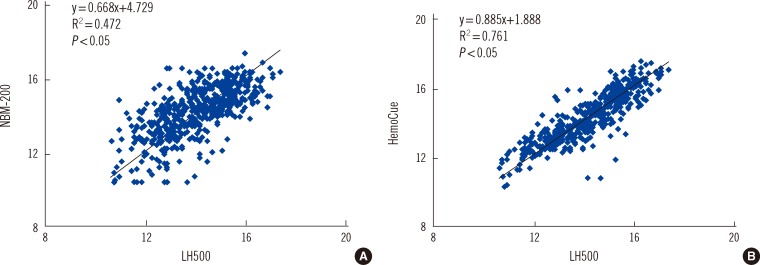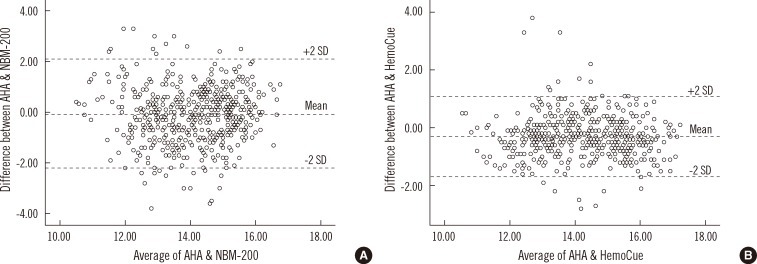Ann Lab Med.
2013 Jul;33(4):261-267. 10.3343/alm.2013.33.4.261.
Comparison of the Accuracy of Noninvasive Hemoglobin Sensor (NBM-200) and Portable Hemoglobinometer (HemoCue) with an Automated Hematology Analyzer (LH500) in Blood Donor Screening
- Affiliations
-
- 1Department of Biomedical Laboratory Science, Eulji University College of Health Science, Seongnam, Korea.
- 2Research Institute of Medicine and Pharmacy, Chung-Ang University, Seoul, Korea.
- 3Quality Assurance Division, Hanmaum Blood Center, Gwacheon, Korea.
- 4Department of Laboratory Medicine, Soonchunhyang University College of Medicine, Seoul, Korea.
- 5Department of Laboratory Medicine, Yonsei University College of Medicine, Seoul, Korea. hyunok1019@yuhs.ac
- KMID: 1707233
- DOI: http://doi.org/10.3343/alm.2013.33.4.261
Abstract
- BACKGROUND
The Hb levels of prospective blood donors are usually determined using a finger prick test. A new noninvasive Hb device has the advantage of not causing any sampling pain. The purpose of this study was to evaluate the accuracy of the noninvasive Hb sensor and to compare its measurements with those of a currently used portable hemoglobinometer.
METHODS
Hb was measured using a noninvasive Hb sensor (NBM-200; OrSense, Israel), a portable hemoglobinometer (HemoCue; HemoCue AB, Sweden), and an automated hematology analyzer (LH500; Beckman Coulter, USA). The correlations between Hb measurements taken by the NBM-200 and HemoCue with those by an automated hematology analyzer were assessed using intraclass correlation coefficients (ICCs). Hb measurements were compared among 3 different Hb level groups.
RESULTS
The mean Hb values of 506 blood donors were 14.1 g/dL by the NBM-200, 14.0 g/dL by the LH500, and 14.3 g/dL by the HemoCue. The correlation between the LH500 and the NBM-200 was substantial (ICC=0.69), while that between the LH500 and the HemoCue agreed almost perfectly (ICC=0.86).
CONCLUSIONS
The possibility to judge to be eligible for donors who are ineligible to donate was substantial when using NBM-200. Even though the NBM-200 has the apparent advantage of noninvasiveness, its use in pre-screening should be given meticulous attention. Since pre-donation testing is crucial to protecting donors' health, complete evaluation of the instrument should be performed prior to use.
Keyword
MeSH Terms
Figure
Reference
-
1. Cable RG. Hemoglobin determination in blood donors. Transfus Med Rev. 1995; 9:131–144. PMID: 7795331.
Article2. Boulton FE, Nightingale MJ, Reynolds W. Improved strategy for screening prospective blood donors for anaemia. Transfus Med. 1994; 4:221–225. PMID: 7820230.
Article3. James V, Jones KF, Turner EM, Sokol RJ. Statistical analysis of inappropriate results from current Hb screening methods for blood donors. Transfusion. 2003; 43:400–404. PMID: 12675728.
Article4. Ross DG, Gilfillan AC, Houston DE, Heaton WA. Evaluation of hemoglobin screening methods in prospective blood donors. Vox Sang. 1986; 50:78–80. PMID: 3962283.
Article5. Noiri E, Kobayashi N, Takamura Y, Iijima T, Takagi T, Doi K, et al. Pulse total-hemoglobinometer provides accurate noninvasive monitoring. Crit Care Med. 2005; 33:2831–2835. PMID: 16352948.
Article6. Neville RG. Evaluation of portable haemoglobinometer in general practice. Br Med J (Clin Res Ed). 1987; 294:1263–1265.
Article7. Lotfi R, Wernet D, Starke U, Northoff H, Cassens U. A noninvasive strategy for screening prospective blood donors for anemia. Transfusion. 2005; 45:1585–1592. PMID: 16181209.
Article8. Gayat E, Aulagnier J, Matthieu E, Boisson M, Fischler M. Non-invasive measurement of hemoglobin: assessment of two different point-of-care technologies. PLoS One. 2012; 7:e30065. PMID: 22238693.
Article9. Landis JR. The measurement of observer agreement for categorical data. Biometrics. 1977; 33:159–174. PMID: 843571.
Article10. Dhingra-Kumar N. CuSO4 gravimetric method for Hb screening of prospective donors--should it be discarded? Transfus Med. 1997; 7:245–247. PMID: 9316227.11. Sawant RB, Bharucha ZS, Rajadhyaksha SB. Evaluation of hemoglobin of blood donors deferred by the copper sulphate method for hemoglobin estimation. Transfus Apher Sci. 2007; 36:143–148. PMID: 17382593.
Article12. Bhaskaram P, Balakrishna N, Radhakrishna KV, Krishnaswamy K. Validation of hemoglobin estimation using Hemocue. Indian J Pediatr. 2003; 70:25–28. PMID: 12619948.
Article13. Neufeld L, García-Guerra A, Sánchez-Francia D, Newton-Sánchez O, Ramírez-Villalobos MD, Rivera-Dommarco J. Hemoglobin measured by Hemocue and a reference method in venous and capillary blood: a validation study. Salud Publica Mex. 2002; 44:219–227. PMID: 12132319.
Article14. Prakash S, Kapil U, Singh G, Dwivedi SN, Tandon M. Utility of HemoCue in estimation of hemoglobin against standard blood cell counter method. J Assoc Physicians India. 1999; 47:995–997. PMID: 10778695.15. Gordeuk VR, Brittenham GM, Bravo J, Hughes MA, Keating LJ. Prevention of iron deficiency with carbonyl iron in female blood donors. Transfusion. 1990; 30:239–245. PMID: 2180144.
Article16. Cogswell ME, Parvanta I, Yip R, Brittenham GM. Innaccuracy of capillary hemoglobin testing for the detection of anemia and iron deficiency during pregnancy. Am J Epidemiol. 1998; 147(S5):206.17. Bahadur S, Jain S, Jain M. Estimation of hemoglobin in blood donors: A comparative study using hemocue and cell counter. Transfus Apher Sci. 2010; 43:155–157. PMID: 20667788.
Article
- Full Text Links
- Actions
-
Cited
- CITED
-
- Close
- Share
- Similar articles
-
- Evaluation of Two Noninvasive Hemoglobin Testing Devices
- Evaluation of a portable hemoglobin photometer for assessment of intra-operative hemoglobin concentrations
- Assessment of Blood Glucose Values Measured by Blood Gas Analyzer or Portable Glucometer
- The Hemoglobin Distribution of Korean Blood Donors
- A Case of Myeloperoxidase Deficiency: its detection on the automated hematology analyzer Technicon H*2




